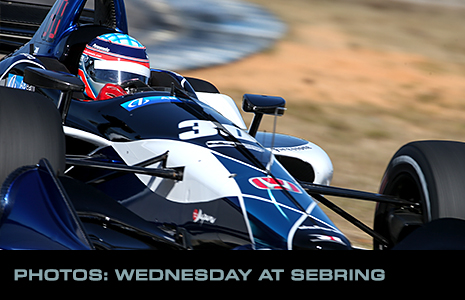Rahal can't get over 'sexy' look of new car after testing it for first time
JAN 24, 2018
SEBRING, Florida – Rahal Letterman Lanigan Racing was the final Verizon IndyCar Series team to test the new universal aero kit. After his first few hours on track, Graham Rahal was ready for more.
But first, he had to admire the car one more time.
“It’s a sexy car,” Rahal said. “Let’s be honest, that’s a big deal for a lot of fans. That’s what they enjoy watching and seeing. It’s a huge, huge step forward.”
Two drivers – rookie Matheus “Matt” Leist for AJ Foyt Racing and Zachary Claman DeMelo in a test for Dale Coyne Racing – tested the new kit for the first time today at Sebring International Raceway, but their teams had tested it previously. Likewise, Carlin tested today at Sebring but also had track time earlier this week at Homestead-Miami Speedway.
 That left RLL – with drivers Rahal and Takuma Sato – as the final team to experience the new kit, which significantly decreases generated downforce, changing the driving dynamic and bringing hands and feet back to the fore. The change suits Rahal.
That left RLL – with drivers Rahal and Takuma Sato – as the final team to experience the new kit, which significantly decreases generated downforce, changing the driving dynamic and bringing hands and feet back to the fore. The change suits Rahal.
“I’d say in general that it’s good,” Rahal said after the morning session on Sebring’s 11-turn, 1.68-mile short road course. “Our car hasn’t been great so far, but it definitely has a different style and characteristic to the way it drives. But my God, do they look good on track.”
The streamlined kit, which has been attached to the existing Dallara IR-12 chassis, lightens downforce, especially in the rear, making the cars more difficult to handle. Drivers’ hands and feet were busy throughout the session, which also included Andretti Autosport and Schmidt Peterson Motorsports.
Like DeMelo, Leist said the new configuration reminded him of his time in Indy Lights, when he won three races for Carlin last season.
“The car is not that much different than the Indy Lights car, which is good for me,” said Leist, a 19-year-old from Novo Hamburgo, Brazil. “The brakes are way better than Indy Lights and the power is a huge difference. But the great thing is that the difference in cornering speed is not that much. … The whole thing is faster than Indy Lights, but it’s not a different way to drive.”
DeMelo, who won the Indy Lights race at Road America in June, had a brief test last summer in the 2017 Indy car and competed in the season finale at Sonoma Raceway with RLL. The differences described by veteran drivers between the 2017 car and the new kit are more drastic than those described by Leist and DeMelo.
“I didn’t do as much time in the old Indy car as (veteran drivers) did, so it wasn’t as big an adjustment for me,” DeMelo said. “It’s more similar to the Indy Lights car than the old Indy car. That’s kind of helped me a little bit. It’s been a fast adjustment so far. … It’s not exactly like the Indy Lights car, but it’s closer to the Indy Lights car than the old Indy car.”
The drastic change in the car isn’t just about appearances. It's about bringing the driver back as the most essential element of the driver/car equation. In recent years, designs had become downforce-heavy. The kit is a throwback to days when drivers had to use a combination of muscle, finesse and strategy to get to the front.
It also is expected to bring back tire management to the top of the strategy checklist. Tire degradation has noticeably increased with the new kit, drivers say, meaning they’ll have to save their tires as much as possible.
“Already I can tell you that tire deg is significantly more than it has been,” Rahal said. “There’s no doubt that’s going to play a role, particularly if the car is loose to start. It isn’t going to get any better, I can tell you that.”
Veteran driver Sebastien Bourdais tested the car today for a third time. He indicated that the change for the upcoming Verizon IndyCar Series season, which opens March 11 at St. Petersburg, Florida, will be momentous.
“In ‘14, ‘15, ‘16 and ‘17, we kept putting more and more downforce into the cars, but it didn’t feel like we were gaining any power,” Bourdais explained. “But now that we’re taking the downforce out of it again, it feels like you have to modulate how you put the power back down and things like that. You feel the car accelerate quite a bit faster. You’re now getting a full glimpse of how much the manufacturers have gone forward with the whole package. That’s kind of cool to see.”
Testing will continue at Sebring on Thursday for some of the teams. An open test for all full-season entries is scheduled Feb. 9-10 at ISM Raceway (formerly Phoenix Raceway). The season opener, the Firestone Grand Prix of St. Petersburg, airs live at 12:30 p.m. ET March 11 on ABC and the Advance Auto Parts INDYCAR Radio Network, kicking off a 17-race season.






















